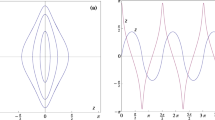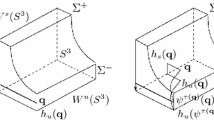Abstract
The restricted three body problem models the motion of a massless body under the influence of the Newtonian gravitational force caused by two other bodies called the primaries. When they move along circular Keplerian orbits and the third body moves in the same plane, one has the restricted planar circular three body problem (RPC3BP). In suitable coordinates, it is a Hamiltonian system of two degrees of freedom. The conserved energy is usually called the Jacobi constant. Llibre and Simó [Math Ann 248(2):153–184, 1980] proved the existence of oscillatory motions for this system. That is, orbits which leave every bounded region but which return infinitely often to some fixed bounded region. To prove their existence they had to assume the ratio between the masses of the primaries to be small enough. In this paper we prove the existence of such motions for any value of the mass ratio \(\mu \) closing the problem of existence of oscillatory motions in the RPC3BP. To obtain such motions, we restrict ourselves to the level sets of the Jacobi constant. We show that, for any value of the mass ratio and for large values of the Jacobi constant, there exist transversal intersections between the stable and unstable manifolds of infinity in these level sets. These transversal intersections guarantee the existence of a symbolic dynamics that creates the oscillatory orbits. The main achievement is to prove the existence of these orbits without assuming the mass ratio \(\mu \) small. When \(\mu \) is not small, this transversality can not be checked by means of classical perturbation theory. Since our method is valid for all values of \(\mu \), we are able to detect a curve in the parameter space, formed by \(\mu \) and the Jacobi constant, where cubic homoclinic tangencies between the invariant manifolds of infinity appear.








Similar content being viewed by others
Notes
An equivalent norm is defined by
$$\begin{aligned} \Vert h\Vert _{\nu ,\sigma }=\sum _{\ell \in \mathbb {Z}}\left\| h^{[\ell ]} e^{-i \ell \widetilde{\alpha }_{\mathrm {h}}} \right\| _{\nu } e^{|\ell |\sigma }, \quad \text {where } \Vert h\Vert _{\nu } = \sup _{v\in D^{u}_{\rho ,\kappa ,\delta }}\left| |v-i/3|^{\nu }|v+i/3|^{\nu } h(v)\right| \end{aligned}$$and \(\widetilde{\alpha }_{\mathrm {h}}\) is given in Lemma 4.1. In particular, if \(\Vert h\Vert _{\nu ,\sigma }\) is bounded, the function \(h(v,\xi -\alpha _{\mathrm {h}}(v))\) is well defined in \(D^u_{\rho ,\kappa ,\delta }\times \mathbb {T}_\sigma \).
References
Arnold, V.I., Kozlov, V.V., Neishtadt, A.I.: Dynamical Systems III. Encyclopaedia of Mathematical Sciences, vol. 3. Springer, Berlin (1988)
Alekseev, V.M.: Quasirandom oscillations and qualitative problems in celestial mechanics. In: Ninth Mathematical Summer School (Kaciveli, 1971) (Russian). Three papers on smooth dynamical systems, pp. 212–341. Izdanie Inst. Mat. Akad. Nauk Ukrain. SSR, Kiev (1972)
Alexeyev, V.M.: Sur l’allure finale du mouvement dans le problème des trois corps. Actes du Congrès International des Mathématiciens (Nice. 1970), Tome 2, pp. 893–907. Gauthier-Villars, Paris (1971)
Alekseev, V.M.: Final motions in the three-body problem and symbolic dynamics. Uspekhi Mat. Nauk 36(4(220)), 161–176, 248 (1981)
Baldomá, I., Fontich, E.: Exponentially small splitting of invariant manifolds of parabolic points. Mem. Am. Math. Soc. 167(792), x-83 (2004)
Baldomá, I., Fontich, E., Guàrdia, M., Seara, T.M.: Exponentially small splitting of separatrices beyond Melnikov analysis: rigorous results. J. Differ. Equ. 253(12), 3304–3439 (2012)
Bolotin, Sergey: Symbolic dynamics of almost collision orbits and skew products of symplectic maps. Nonlinearity 19(9), 2041–2063 (2006)
Delshams, A., Kaloshin, V., de la Rosa, A., Seara, T.: Parabolic orbits in the restricted three body problem. (2014). http://arxiv.org/abs/1501.01214
Delshams, A., Seara, T.M.: An asymptotic expression for the splitting of separatrices of the rapidly forced pendulum. Commun. Math. Phys. 150(3), 433–463 (1992)
Delshams, A., Seara, T.M.: Splitting of separatrices in Hamiltonian systems with one and a half degrees of freedom. Math. Phys. Electron. J. 3(4), (1997)
Erdélyi, A.: Asymptotic Expansions. Dover Publications Inc., New York (1956)
Gelfreich, V.G.: Melnikov method and exponentially small splitting of separatrices. Phys. D 101(3–4), 227–248 (1997)
Gelfreich, V.G.: Separatrix splitting for a high-frequency perturbation of the pendulum. Russ. J. Math. Phys. 7(1), 48–71 (2000)
Galante, J., Kaloshin, V.: Destruction of invariant curves using the ordering condition. http://www.terpconnect.umd.edu/~vkaloshi (2010)
Galante, J., Kaloshin, V.: The method of spreading cumulative twist and its application to the restricted circular planar three body problem. http://www.terpconnect.umd.edu/~vkaloshi (2010)
Galante, J., Kaloshin, V.: Destruction of invariant curves in the restricted circular planar three-body problem by using comparison of action. Duke Math. J. 159(2), 275–327 (2011)
Gorodetski, A., Kaloshin, V.: Hausdorff dimension of oscillatory motions for restricted three body problems. http://www.terpconnect.umd.edu/~vkaloshi (2012)
Guardia, M., Olivé, C., Seara, T.: Exponentially small splitting for the pendulum: a classical problem revisited. J. Nonlinear Sci. 20(5), 595–685 (2010)
Guardia, M.: Splitting of separatrices in the resonances of nearly integrable Hamiltonian systems of one and a half degrees of freedom. Discret. Contin. Dyn. Syst. A. 33(7), 2829–2859 (2012)
Holmes, P., Marsden, J., Scheurle, J.: Exponentially small splittings of separatrices with applications to KAM theory and degenerate bifurcations. In: Hamiltonian Dynamical Systems (Boulder, CO, 1987). Contemp. Math., vol. 81. American Mathematical Society, Providence (1988)
Katok, A., Hasselblatt, B.: Introduction to the modern theory of dynamical systems. Encyclopedia of Mathematics and its Applications, vol. 54. Cambridge University Press, Cambridge (1995)
Lochak, P., Marco, J.-P., Sauzin, D.: On the splitting of invariant manifolds in multidimensional near-integrable Hamiltonian systems. Mem. Am. Math. Soc. 163(775), viii+145 (2003)
Llibre, J., Simó, C.: Oscillatory solutions in the planar restricted three-body problem. Math. Ann. 248(2), 153–184 (1980)
Llibre, J., Simó, C.: Some homoclinic phenomena in the three-body problem. J. Differ. Equ. 37(3), 444–465 (1980)
McGehee, R.: A stable manifold theorem for degenerate fixed points with applications to celestial mechanics. J. Differ. Equ. 14, 70–88 (1973)
Melnikov, V.K.: On the stability of the center for time periodic perturbations. Trans. Mosc. Math. Soc. 12, 1–57 (1963)
Meyer, K.R., Hall, G.R.: Introduction to Hamiltonian Dynamical Systems and the \(N\)-Body Problem. Springer, New York (1992)
Moeckel, R.: Heteroclinic phenomena in the isosceles three-body problem. SIAM J Math Anal 15(5), 857–876 (1984)
Moser, J.: Stable and Random Motions in Dynamical Systems. Princeton University Press, Princeton (1973). (With special emphasis on celestial mechanics, Hermann Weyl Lectures, the Institute for Advanced Study, Princeton, NJ, Ann. Math. Stud., No. 77)
Martínez, R., Pinyol, C.: Parabolic orbits in the elliptic restricted three body problem. J. Differ. Equ. 111(2), 299–339 (1994)
Neĭshtadt, A.I.: The separation of motions in systems with rapidly rotating phase. Prikl. Mat. Mekh. 48(2), 197–204 (1984)
Poincaré, H.: Sur le problème des trois corps et les équations de la dynamique. Acta Math. 13, 1–270 (1890)
Sauzin, D.: A new method for measuring the splitting of invariant manifolds. Ann. Sci. École Norm. Sup. (4), 34(2), 159–221 (2001)
Sitnikov, K.: The existence of oscillatory motions in the three-body problems. Sov. Phys. Dokl. 5, 647–650 (1960)
Treschev, D.: Separatrix splitting for a pendulum with rapidly oscillating suspension point. Russ. J. Math. Phys. 5(1), 63–98 (1997)
Xia, Z.: Mel’nikov method and transversal homoclinic points in the restricted three-body problem. J. Differ. Equ. 96(1), 170–184 (1992)
Acknowledgments
The authors acknowledge useful discussions with V. Kaloshin and A. Gorodetski. They want to thank the referees for their help to improve the final version of the manuscript and Mike Jeffrey for his careful reading of the paper and helpful comments. They have been partially supported by the Spanish MINECO-FEDER Grant MTM2012-31714 and the Catalan Grant 2014SGR504. M. G. and P. M warmly thank the Institute for Advanced Study for their hospitality, stimulating atmosphere and support. During his stay in the Institute for Advanced Study, M. G. was also partially supported by the NSF grant DMS-0635607. T. S. has been partially supported by the Russian Scientific Foundation grant 14-41-00044 and Marie Curie Action FP7-PEOPLE-2012-IRSES, BREUDS.
Author information
Authors and Affiliations
Corresponding author
Appendix. Computation of the function L: proof of Proposition 3.1
Appendix. Computation of the function L: proof of Proposition 3.1
In this appendix, we give the properties of the function \(L\) in (28), stated in Proposition 3.1. We first state an auxiliary lemma, which gives some properties of the potential \(V\) in (11).
Lemma 7.1
The Fourier coefficients of the function
where \(V\) is defined in (11) and \(\widetilde{r}_{\mathrm {h}}\) in (10), are
where \(c_j=\left( \begin{array}{c}-1/2\\ j\end{array}\right) \), \(\delta _0(0) = 1\) and \(\delta _0(\ell ) = 0\) for \(\ell \ne 0\).
Proof
We use the identity
where \(\alpha = A/(2\beta )\) and \(\beta = (1- \sqrt{1-A^2})/A\), and
to obtain
\(\square \)
Remark 7.2
A more classical approach to prove this lemma would be to expand the potential in terms of the Legendre polynomials and then extract from these polynomials the Fourier coefficients of \(\widehat{U}\). This is the approach followed in [23, 30]. Here we follow the approach in [8] and we provide a direct way to compute an explicit formula for these Fourier coefficients.
Now we prove Proposition 3.1.
Proof Proposition 3.1
First, we observe that the Poincaré function \(L\) in (28) can be written as
Now, using that
and
with
to compute \(L^{[\ell ]}\) we use the expansions in Lemma 7.1 obtaining, when \(\ell \ne 0\)
with
To compute \(\mathcal {I}(\ell ,j)\) we use the change of variables \(v = \frac{1}{2}\left( \frac{1}{3} \tau ^3 + \tau \right) \) given in Lemma 4.1 obtaining
where we have introduced the notation
to write the Poincaré function Fourier coefficients as
The first observation is that
All the Fourier coefficients are real and we just need to compute them for \(\ell >0\):
and then
To compute the integrals \(I(\ell ,m,n)\) for \(\ell >0\), one uses the method in [11] (see also [23, 30]) changing the path of integration to a suitable complex path \(\mathrm {Re\, }(\tau + \frac{\tau ^3}{3})= 0\) up to a neighborhood of the singularity \(\tau = i\).
Using that \(\tau + \frac{\tau ^3}{3}=\frac{2}{3}i +\mathcal {O}((\tau -i)^2)\), to bound the integrals (see [8]) it is enough to reach a neighborhood of the singularity \(\tau =i\) of order \(\mathcal {O}(G_0^{-3/2})\), obtaining that there exists a constant \(K>0\) such that, for any \(\ell >0\) and \(m,n\ge 1\):
and therefore
To obtain the dominant terms of the function \(L\), which correspond to \(\ell =1,2\), we can use the results in [8] (see also [30]) to obtain
Thus,
To obtain the formula for \(L^{[1]}\) in Proposition 3.1 it is enough to use that \(\mu (1-\mu )^3-(1-\mu )\mu ^3=\mu (1-\mu )(1-2\mu )\). \(\square \)
Rights and permissions
About this article
Cite this article
Guardia, M., Martín, P. & Seara, T.M. Oscillatory motions for the restricted planar circular three body problem. Invent. math. 203, 417–492 (2016). https://doi.org/10.1007/s00222-015-0591-y
Received:
Accepted:
Published:
Issue Date:
DOI: https://doi.org/10.1007/s00222-015-0591-y




